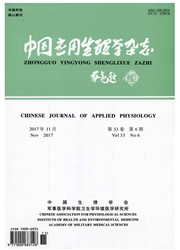

 中文摘要:
中文摘要:
目的:建立记录小鼠在体海马“前穿通纤维-齿状回”(PP—DG)神经通路长时程增强(LTP)的方法。方法:动物麻醉后固定于立体定位仪上,参照立体定位参数将刺激电极插入至前穿通纤维,记录电极插入至DG颗粒细胞层,而后进行LTP的诱发和记录。结果:对各种实验备件优化后,成功记录了Balb/c小鼠海马PP-DG通路LTP。应用该方法对快速老化模型小鼠(SAM)的快速老化亚系SAMP8和抗快速老化亚系SAMRl海马神经突触可塑性进行考察,结果表明在体海马LTP与脑片LTP和行为学实验结果相符。结论:成功建立了小鼠在体海马PP-DG通路LTP的记录方法,可用于整体动物神经突触可塑性的评价。
 英文摘要:
英文摘要:
Aim: To establish the method of long-term potentiation(LTP) recording in hippocampus in anaesthetized mice in vivo. Methods: Mouse was anaesthetized and then placed in the stereotaxic apparatus.The recording electrode was located at the cell body layer of dentate granule cells and the stimulating electrode at the perforant path according to stereotaxic parameters.Then the LTP was evoked and recorded. Results: Alter optimizing of experimental factor, the LTP in PP-DG path in anaesthetized Balb/c mice was successfully recorded.The changes of synaptic plasticity were also observed in SAMP8 and SAMRI by using the optimized method. The results were coincident with the behavioral tests and LTP in hippocampal slices that we reported before. Conclusion: The method of LTP recording in vivo in hippocampus in anaesthetized mice was successfully established and could be used to evaluate the synaptic plasticity in vivo.
 同期刊论文项目
同期刊论文项目
 同项目期刊论文
同项目期刊论文
 Age-related expression of STUB 1 in senescence-accelerated mice and its response to anti-Alzheimer’s
Age-related expression of STUB 1 in senescence-accelerated mice and its response to anti-Alzheimer’s Danggui-Shaoyao-San and its active fraction JD-30 improve Aβ-induced spatial recognition deficits in
Danggui-Shaoyao-San and its active fraction JD-30 improve Aβ-induced spatial recognition deficits in 期刊信息
期刊信息
